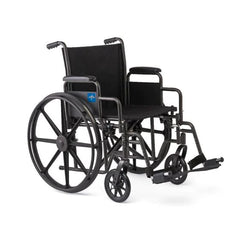Every wheelchair is NOT created equal. There are different types for different purposes. Should you have a power wheelchair vs. a manual wheelchair? What about a transport chair, is that covered? If it feels difficult to understand which one is right for your needs, don't worry, you aren't the only one! That's why in this article we are diving in to:
- Available wheelchair types
- Different features to consider with a wheelchair
- Basic information on how wheelchairs can be paid for
Let's get started!
Standard Wheelchair


This type of wheelchair is the one most people picture when they think of a wheelchair. Even though this type is common, there are some important things to consider when using one. Proper positioning in the wheelchair is vital to keeping the person safe and preventing pressure sores from forming. Making sure the wheelchair is the correct size for the person is crucial to help provide comfort for the person. If use of the chair is going to be temporary, and not daily, this type of chair can be a good option because it can be obtained quickly with a prescription from a physician or nurse practitioner and the person's height and weight.
But if the person needs a chair for "just in case," we often recommend buying a recycled one from a thrift store. This saves your ability to use the insurance benefit if a custom one is needed for daily use in the future. More on paying for wheelchairs later!
Transport Wheelchair


A transport wheelchair can benefit caregivers when taking loved ones to appointments, making it easier to lift the chair into the car. It's also great if the person can walk, but long distances are a challenge. Unfortunately, these chairs aren't covered by insurance. So if you need one, get it from us here!
Power Wheelchair


Power wheelchairs can be beneficial for people that have cardiovascular issues or lack arm function to push a standard wheelchair. Power wheelchairs have many features to facilitate independence with daily tasks. We can help you figure out what features are best for you and then help you learn how to use them. Most importantly, we help you through the insurance process so it gets covered!
Custom Manual Wheelchairs
Did you know that custom manual wheelchairs aren't just for those with a spinal cord injury? If the person has the strength to push a chair and needs to use the chair daily, a custom chair is always a better option than a standard chair. Custom chairs are lighter and have all types of customizable features to make life easier when using it. Like a power chair, it requires an evaluation to get it covered by insurance, so let's dive into how to do that.
How to get a wheelchair covered by insurance
Mobility devices, including walkers, wheelchairs, and scooters can be covered by insurance in specific situations. It requires a visit to the doctor or nurse practitioner, a prescription, and sometimes an occupational or physical therapy visit. If a mobility device has been ordered within the past 5 years, additional documentation about why that device is no longer appropriate is required to try to get it covered. Most of the time, this only occurs when there's been a decline in level of ability.
Going through this process takes time, and usually it takes 2–3 months to get a custom chair or power chair. But this time investment can be worth it because the cost of the custom devices is so high. The best place to start is to schedule a visit with your healthcare provider to get started.
In Conclusion...
Navigating the world of wheelchairs can be a complex journey, with a myriad of options tailored to meet diverse needs. Whether it's understanding the difference between a standard, transport, power, or custom manual wheelchair, each type serves a unique purpose and offers different features to enhance mobility and comfort. From considering the right fit and the necessity of various features to the specifics of insurance coverage, this article shed light on these crucial aspects.
Remember, the right wheelchair not only improves mobility but also impacts overall quality of life, making an informed choice essential. Armed with this knowledge and understanding of the process to get a wheelchair covered by insurance, you're now better prepared to make a decision that best suits your or your loved one's needs. Take the time to consult with healthcare professionals, and don't hesitate to reach out for guidance on selecting the perfect wheelchair to navigate life's paths more freely.







